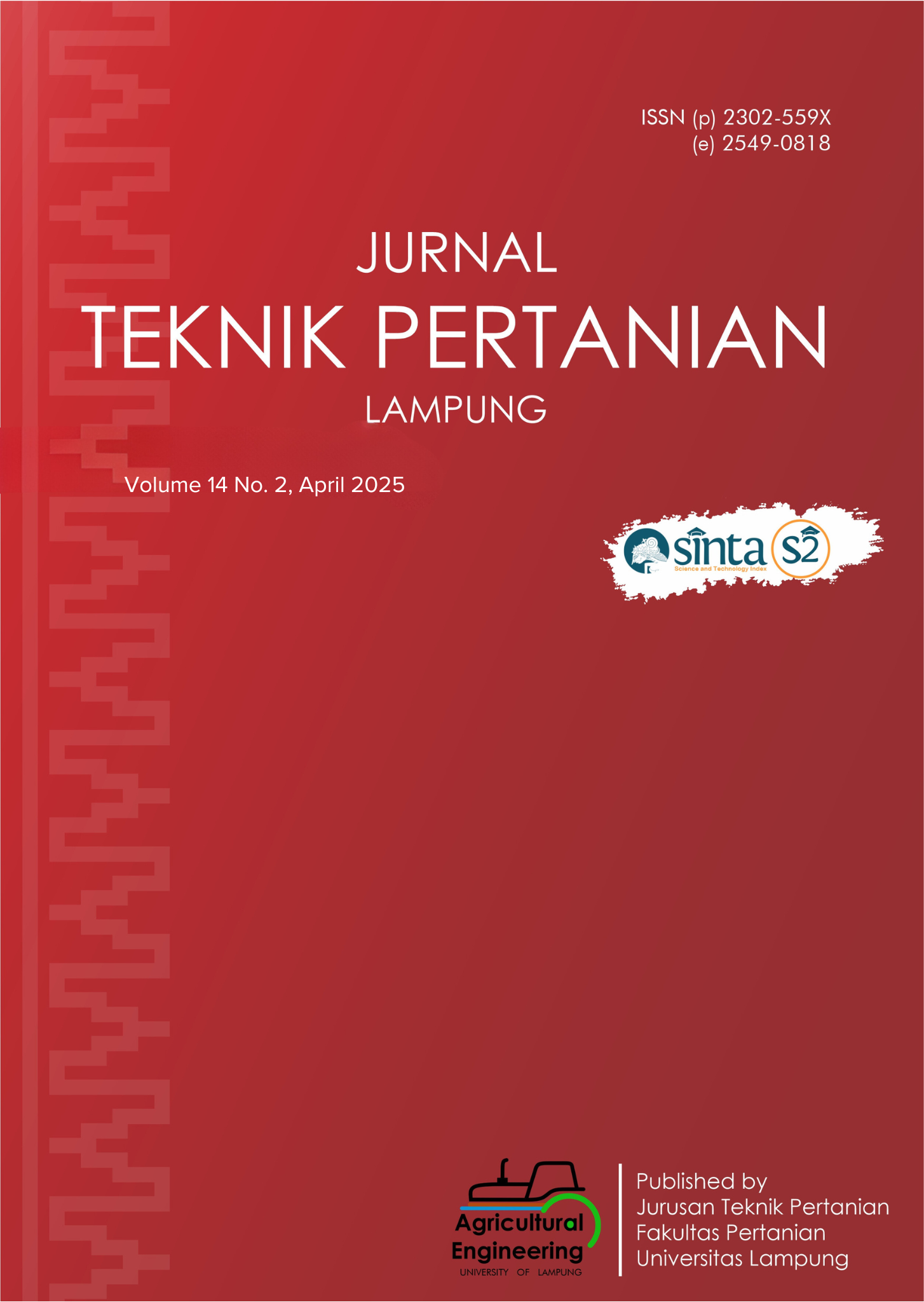Geostatistical Approach and Drone Image Analysis of the Spatial Distribution of Bacterial Leaf Blight in Rice Plants
DOI:
https://doi.org/10.23960/jtep-l.v14i2.582-593 Abstract View: 194
Abstract View: 194
Abstract
Bacterial leaf blight caused by the bacterium Xanthomonas oryzae is an important disease because it can cause severe damage and can infect the vegetative and generative phases of rice plants. This research was carried out to determine the spatial distribution of leaf blight using a geospatial approach and drone imagery. The results of this research indicate that the distribution of bacterial leaf blight disease on land at the research location tends to be higher in the northern part compared to the southern part of the land. The attack rate value at the end of the observation ranged between 20-68%. The distribution of leaf blight on land can be described through simulations using a geostatistical approach and confirmed by aerial imagery. Aerial imagery, especially binary imagery and kriging imagery, mutually confirm (crosscheck) the occurrence of leaf blight on land. Aerial images that are processed into binary images have the potential to be a remote sensing method that can make it easier to observe the distribution of diseases on land, especially leaf blight.
Keywords: Campestris, Drone Imagery, Geospatial, Rice, Xanthomona.
Downloads
References
Alizadeh, M., Moharrami, M., & Rasouli, A.A. (2017). Geographic information system (GIS) as a Tool in the epidemiological assessment of wetwood disease on elm trees in Tabriz City, Iran. Cercetari Agronomice in Moldova, 50(2), 91–100.
Andika, I.M.P.C., Wijaya, I.M.A.S., & Gunadnya, I.B.P. (2019). Pendugaan intensitas serangan penyakit blas pada tanaman padi melalui pendekatan citra NDVI (normalized difference vegetation index). Jurnal Beta (Biosistem dan Teknik Pertanian, 7(2), 287–296. https://doi.org/10.24843/JBETA.2019.v07.i02.p09
Annan, E.B., Aidoo, A.B., Ejeh, C.J, Emmanuel, A., & Ocran, D. (2019). Mapping of porosity, permeability and thickness distribution: Application of geostatistical modeling for the jubilee oilfield in Ghana. Geosciences, 9(2), 27–49.
Aprillian, M., Sitorus, S.H., & Ristian, U. (2020). Perbandingan metode gabungan histogram equalization dengan contrast stretching untuk perbaikan kualitas citra radiologi. Coding Jurnal Komputer dan Aplikasi, 8(2), 55–66. https://doi.org/10.26418/coding.v8i2.41501
Bhahri, S., & Rachmat. (2018). Transformasi citra biner menggunakan metode thresholding dan otsu thresholding. Jurnal Sistem Informasi dan Teknologi Informasi, 7(2), 195–203.
BPS Kabupaten Sidoarjo. (2020). Kabupaten Sidoarjo dalam Angka 2020. Badan Pusat Statistik Kabupaten Sidoarjo. https://sidoarjokab.bps.go.id/
Dinas Pertanian dan Ketahanan Pangan Daerah Istimewa Yogyakarta. (2019). Deskripsi Padi Varietas Inpari 42 Agritan GSR. Direktorat Perbenihan Direktorat Jendral Tanaman Pertanian Kementrian Pertanian.
Dinata, K., Puspitasari, M., Calista, I., Oktavia, Y., Rosmanah, S., Yahumri, Y., Suyanto, H., Yuliasari, S., & Sastro, Y. (2021). Keragaan serangan hama dan penyakit serta hasil tiga varietas unggul baru padi pada display teknologi pengendalian hayati. Prosiding Seminar Nasional Lahan Suboptimal Ke-9 Tahun 2021, 555–562.
Fadlilah, D.M., Setiawan, A.W., & Handoko, Y.A. (2022). Isolasi, karakterisasi dan uji stabilitas pH bakteriofag Xanthomonas oryzae dari area persawahan. Jurnal Ilmiah Pertanian, 19(2), 118–125. https://doi.org/10.31849/jip.v19i2.9417
Fauzi, I., & Hariyadi, E.S. (2018). Analisis geostatistik dalam menentukan keseragaman nilai kepadatan tanah dasar. Jurnal Teknik Sipil, 25(3), 195.
Guedes, L.P.C., Bach, R.T., & Uribe-Opazo, M.A. (2020). Nugget effect influence on spatial variability of agricultural data. Engenharia Agrícola, 40(1), 96–104. https://doi.org/10.1590/1809-4430-eng.agric.v40n1p96-104/2020
Herawati, A. (2016). Isolasi dan karakterisasi penyebab penyakit hawar daun bakteri (Xanthomonas oryzae pv. Oryzae l.) pada tanaman padi di wilayah Sulawesi Selatan. Perbal: Jurnal Pertanian Berkelanjutan, 4(3), 1–14.
Indrawan, A.D., Nirwanto, H., Windriyanti, W., & Jati, W.W. (2024). Study of the symptoms and distribution pattern detection of ring spot disease (Leptosphaeria sp.) on sugarcane plants using aerial images. Proceedings of the 8th International Conference of Food, Agriculture and Natural Resources & the 2nd International Conference of Sustainable Industrial Agriculture (IC-FANRes-IC-SIA 2023), 41, 255-268. https://doi.org/10.2991/978-94-6463-451-8_23
Jabeen, R., Iftikhar, T., & Batool, H. (2012). Isolation, characterization, preservation and pathogenicity test of Xanthomonas oryzae PV. Oryzae causing BLB disease in Rice. Pakistan Journal of Botany, 44(1), 261–265.
Khaeruni, A., Taufik, M., Wijayanto, T., & Johan, E. (2014). Perkembangan penyakit hawar daun bakteri pada tiga varietas padi sawah yang diinokulasi pada beberapa fase pertumbuhan. Jurnal Fitopatologi Indonesia, 10(4), 119–125. https://doi.org/10.14692/jfi.10.4.119
Khan, M., Rafi, A., Abbas, A., Ali, T., & Hassan, A. (2015). Assessment of yield lossess caused by bacterial blight of rice in upper dir, Khyber Pakhtunkhwa Province. Asian J Agri Biol, 3(2), 74–78.
Lamichhane, J.R., Fabi, A., Ridolfi, R., & Varvaro, L. (2013). Epidemiological study of hazelnut bacterial blight in Central Italy by using laboratory analysis and geostatistics. PLoS ONE, 8(2), 1–14. https://doi.org/10.1371/journal.pone.0056298
Laraswati, R., Ramdan, E. P., & Kulsum, U. (2021). Identifikasi penyebab penyakit hawar daun bakteri pada kombinasi pola tanam system of rice intenification (SRI) dan Jajar Legowo. Agropross: National Conference Proceedings of Agriculture, 5, 302–311. https://doi.org/10.25047/agropross.2021.234
Nasution, T.A., Herdiyeni, Y., Kusuma, W.A., Tjahjono, B., & Siregar, I.Z. (2023). Kecerdasan buatan untuk monitoring hama dan penyakit pada tanaman eucalyptus: Systematic literature review. Jurnal Ilmu Komputer dan Agri-Informatika, 10(2), 224–237. https://doi.org/10.29244/jika.10.2.224-237
Nuraini, F. (2015). Karakterisasi isolat Xanthomonas oryzae pv. oryzae yang menyerang tanaman padi di Kabupaten Jember menggunakan teknik RAPD (random amplified polymorphic DNA). [Undergraduate Thesis], University of Jember.
Parasayu, K.S., Wicaksono, K.S., & Munir, M. (2016). Pengaruh sifat fisik tanah terhadap jamur akar putih pada tanaman karet. Jurnal Tanah Dan Sumberdaya Lahan, 3(2), 359–364.
Purwati, P., & Nugrahini, T. (2020). Identifikasi mikroba rhizosfer pada tanaman lada malonan 1 (Piper nigrum L.) di Kecamatan Muara Badak Kabupaten Kutai Kartanegara. AGRIFOR: Jurnal Ilmu Pertanian dan Kehutanan, 19(2), 223. https://doi.org/10.31293/af.v19i2.4640
Rahadi, I.K.S., Wijaya, I.M.A.S., & Tika, I.W. (2019). Intensitas serangan hama tikus tanaman padi menggunakan metode pengamatan keliling berhubungan linier dengan luas serangan hasil analisi foto udara. Jurnal BETA (Biosistem Dan Teknik Pertanian), 7(2), 279. https://doi.org/10.24843/JBETA.2019.v07.i02.p08
Setiawan, J., Nirwanto, H., & Windriyanti, W. (2023). Estimation of yield damage due to whitefly pest attack on cayenne pepper plants based on drone imagery. Himalayan Journal of Agriculture, 4(1), 1–7. https://himjournals.com/article/articleID=1109
Sudir, & Yuliani, D. (2016). Composition and distribution of Xanthomonas oryzae pv. Oryzae pathotypes, the pathogen of rice bacterial leaf blight in Indonesia. Agrivita: Journal of Agricultual Science, 38(2), 174–185. https://doi.org/10.17503/agrivita.v38i2.588
Suresh, S., Yenjerappa, S., Naik, M., Mallesh, S., & Kalibavi, C. (2013). Studies on cultural and physiological characters of Xanthomonas oryzae pv. oryzae causing bacterial blight of rice. Karnataka Journal Agricultural Sciences, 26(2), 214–216.
Syamsiah, M., & Nurlailah, L. (2018). Aplikasi asap cair suren terhadap bakteri Xanhtomonas oryzae pv. Oryzae penyebab hawar daun bakteri pada padi secara in vitro. Agroscience (Agsci), 8(2), 198. https://doi.org/10.35194/agsci.v8i2.485
Thenmozhi, K., & Reddy, U.S. (2018). Image processing techniques for insect shape detection in field crops. 2017 International Conference on Inventive Computing and Informatics (ICICI), 699–704. https://doi.org/10.1109/ICICI.2017.8365226
Vélez, S., Ariza-Sentís, M., & Valente, J. (2023). Efficient assessment of crop spatial variability using UAV imagery: A geostatistical approach. Environmental Sciences Proceedings, 29(1), 48. https://doi.org/10.3390/ECRS2023-16643
Vinodhini, J., Kannan, R., Sankareswari, R.U., Akila, R., & Pillai, M.A. (2017). Characterization of New bacterial leaf blight of rice caused by Pantoea stewartii subsp. indologenes in Southern Districts of Tamil Nadu. International Journal of Environment, Agriculture and Biotechnology, 2(6), 3279–3284. https://doi.org/10.22161/ijeab/2.6.64
Wening, R.H., & Susanto, U. (2016). Varietas unggul padi tahan hawar daun bakteri : perakitan dan penyebaran di sentra produksi. Iptek Tanaman Pangan, 11(2).
Zahrah, S., Saptono, R., & Suryani, E. (2016). Identifikasi gejala penyakit padi menggunakan operasi morfologi citra. Seminar Nasional Ilmu Komputer (SNIK), 2016.
Downloads
Published
How to Cite
Issue
Section
License
Authors who publish with this journal agree to the following terms:
Authors retain copyright and grant the journal right of first publication with the work simultaneously licensed under a Creative Commons Attribution-ShareAlike 4.0 International Lice that allows others to share the work with an acknowledgement of the work's authorship and initial publication in this journal.
Authors are able to enter into separate, additional contractual arrangements for the non-exclusive distribution of the journal's published version of the work (e.g., post it to an institutional repository or publish it in a book), with an acknowledgement of its initial publication in this journal.
Authors are permitted and encouraged to post their work online (e.g., in institutional repositories or on their website) prior to and during the submission process, as it can lead to productive exchanges, as well as earlier and greater citation of published work (See The Effect of Open Access).
Jurnal Teknik Pertanian Lampung

JTEPL is licensed under a Creative Commons Attribution-ShareAlike 4.0 International License.













